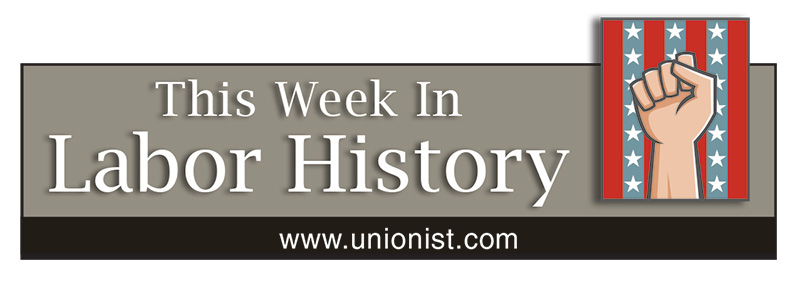This week in labor history: July 1-7

JULY 1
1929 – Some 1,100 streetcar workers strike in New Orleans, spurred the creation of the po’ boy sandwich by a local sandwich shop owner and one-time streetcar man Bennie Martin and his wife who fed any striker who showed up.
1956 – In what was to be a month-long strike, 650,000 steelworkers shut down the industry demanding wage and working condition improvements. They won all their demands, including a union shop.
1983 – Copper miners begin a years-long, bitter strike against Phelps-Dodge in Clifton, Ariz. Democratic Gov. Bruce Babbitt repeatedly deployed state police and National Guardsmen to assist the company over the course of the strike, which broke the union.
JULY 2
1964 – President Johnson signs Title VII of the Civil Rights Act of 1964, forbidding employers and unions from discriminating on the basis of race, color, gender, nationality or religion.
2009 – The Labor Dept. reports that U.S. employers cut 467,000 jobs over the prior month, driving the nation’s unemployment rate up to a 26-year high of 9.5 percent.
JULY 3
1835 – Children, employed in the silk mills in Paterson, N.J., go on strike for 11-hour day and six-day week. A compromise settlement resulted in a 69-hour work week.
1860 – Feminist and Labor activist Charlotte Perkins Gilman born in Hartford, Conn. Her landmark study, “Women and Economics,” was radical: It called for the financial independence of women and urged a network of child care centers.
JULY 4
1924 – Five newspaper boys from the Baltimore Evening Sun died when the steamer they were on, the Three Rivers, caught fire near Baltimore, Md. They are remembered every year at a West Baltimore cemetery, toasted by former staffers of the now-closed newspaper.
2004 – Building trades workers lay the cornerstone of the Freedom Tower on the site of the World Trade Center in New York City. The WTC had been leveled by a terrorist attack three years earlier. Nearly 3,000 died at the WTC and in other attacks in the eastern U.S. on the same day.
JULY 5
1934 – West Coast Longshoremen’s Strike, Battle of Rincon Hill, San Francisco. Some 5,000 strikers fought 1,000 police, scabs and national guardsmen. Two strikers were killed, 109 people injured. The incident, forever known as “Bloody Thursday,” led to a general strike.
1935 – President Franklin D. Roosevelt signs the National Labor Relations Act.
JULY 6
1889 – Two strikers and a bystander are killed, 30 seriously wounded by police in Duluth, Minn. The workers, mostly immigrants building the city’s streets and sewers, struck after contractors reneged on a promise to pay $1.75 a day.
1988 – Explosions and fires destroy the Piper Alpha drilling platform in the North Sea, killing 167 oil workers — the worst loss of life ever in an offshore oil disaster. The operator, Occidental, was found guilty of having inadequate maintenance and safety procedures, but no criminal charges were ever brought.
JULY 7
1882 – Striking New York longshoremen meet to discuss ways to keep new immigrants from scabbing. They were successful, at least for a time. On July 14, 500 newly arrived Jews marched straight from their ship to the union hall. On July 15, 250 Italian immigrants stopped scabbing on the railroad and joined the union.
1903 – Mary Harris “Mother” Jones begins “The March of the Mill Children,” when, accompanied part of the way by children, she walked from Philadelphia to President Theodore Roosevelt’s home on Long Island to protest the plight of child laborers. One of her demands: reduce the children’s work week to 55 hours.
(Labor History is provided by Union Communications Services, since 1981 North America’s premier publisher and distributor of newsletters, leadership training programs for shop stewards and officers, website materials and other powerful use-it-today strategies and tools to help leaders and activists build union power. Reach them at unionist.com.)


Leave a Reply